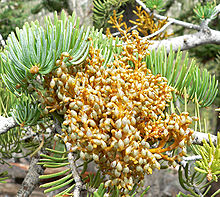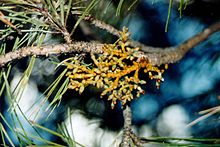- Arceuthobium
-
Dwarf Mistletoes 
Arceuthobium abietinum Scientific classification Kingdom: Plantae (unranked): Angiosperms (unranked): Eudicots (unranked): Core eudicots Order: Santalales Family: Santalaceae Genus: Arceuthobium
M.Bieb.Species The genus Arceuthobium, commonly called Dwarf Mistletoes, is a genus of 42 species of parasitic plants that parasitize members of Pinaceae and Cupressaceae in North America, Central America, Asia and Africa. Of the 42 species, 39 and 21 are endemic to North America and the United States, respectively. They all have very reduced shoots and leaves (mostly reduced to scales) with the bulk of the plant living under the host's bark. Recently the number of species within the genus has been reduced to 26 as a result of more detailed genetic analysis.[1]
In western forest ecosystems of North America, numerous dwarf mistletoe species are considered to be serious forest-borne disease agents. Severe dwarf mistletoe infection can result in a reduction in tree growth, premature tree mortality, reduced seed and cone development, reduced wood quality, and increase the susceptibility of the host tree to pathogen and/or insect attack. Most of the commercially important conifers in western North America are parasitized by one or more dwarf mistletoes.
The interaction between dwarf mistletoes and their host can be generalized as a source-to-sink relationship. Dwarf mistletoes derive the majority of their nutrition from the host’s vascular tissues. Dwarf mistletoes have a root-like endophytic system, composed of primary and secondary haustoria, which invade, but do not injure, both the xylem and phloem of the host. Because this root-like endophytic system is not soil-borne, dwarf mistletoes are solely dependent on their host for water. Along a xylem-to-xylem link, dwarf mistletoes draw water from their host due to differences in water potential between dwarf mistletoes and their hosts. Dwarf mistletoes facilitate this water gradient by having greater transpiration rates, thereby producing lower water potentials and allowing water to flow from the hosts to the dwarf mistletoes. The water gradient or transpiration stream is consistently maintained, even when the host is under moderate water deficits.
In addition to host-water dependence, dwarf mistletoes must acquire carbohydrate and mineral nutrition from their hosts. Dwarf mistletoes have both chlorophyll a and chlorophyll b and the necessary mechanisms for photosynthesis, but chlorophyll concentrations in dwarf mistletoes are approximately 1/5 to 1/10 of those found in their host’s foliage, and dwarf mistletoes have low photosynthetic rates as measured by the rate of carbon fixation. The principal carbohydrate transported from the host to dwarf mistletoe is sucrose. Dwarf mistletoes are phloem deficient; therefore, dwarf mistletoes draw carbohydrates from their hosts by connections to the host phloem and ray parenchyma. The rate of carbohydrate transport between dwarf mistletoes varies according to season, but dwarf mistletoes continuously draw carbohydrates from their hosts throughout the year.
They are dioecious, individual plants being either male or female. The fruit is unusual in that it builds up hydrostatic pressure internally when ripe and shoots the single sticky seed up to speeds nearly 50 miles per hour (80 km/h), an example of rapid plant movement. The seeds are enveloped in a hygroscopic, glue-like substance called viscin. Many fail to land on a suitable host's shoot, but just as many succeed, and in this way they are spread through the forests as a pest front. The spread of dwarf mistletoes in forest stands is greatest from the overstory to the understory (gravity). Advantageous stand conditions for the spread of dwarf mistletoes include an uneven-aged stand structure with severely infected-hosts in dominant and codominant crown classes, species composition dominated by the primary host, and tree densities that are between 175 - 500 trees/ha.
There are also a number of species from Europe and Asia including one of the smallest in the genus, A. minutissimum that lives on its host, Pinus wallichiana in the Himalaya.
Species
- Arceuthobium abietinum Engelm. ex Munz
- Arceuthobium americanum Nutt. ex Engelm.
- Arceuthobium apachecum Hawksworth & Wiens
- Arceuthobium blumeri A. Nels.
- Arceuthobium californicum Hawksworth & Wiens
- Arceuthobium campylopodum Engelm.
- Arceuthobium cyanocarpum (A. Nels. ex Rydb.) A. Nels.
- Arceuthobium divaricatum Engelm.
- Arceuthobium douglasii Engelm.
- Arceuthobium gillii Hawksworth & Wiens
- Arceuthobium globosum Hawksw. & Wiens
- Arceuthobium laricis (Piper) St. John
- Arceuthobium littorum Hawksworth, Wiens & Nickrent
- Arceuthobium microcarpum (Engelm.) Hawksworth & Wiens
- Arceuthobium minutissimum
- Arceuthobium monticola Hawksworth, Wiens & Nickrent
- Arceuthobium occidentale Engelm.
- Arceuthobium oxycedri
- Arceuthobium pusillum Peck
- Arceuthobium siskiyouense Hawksworth, Wiens & Nickrent
- Arceuthobium tsugense (Rosendahl) G.N. Jones
- Arceuthobium vaginatum (Humb. & Bonpl. ex Willd.) J. Presl (Syn. Viscum vaginatum Humb. & Bonpl. ex Willd.)
References and external links
- ^ Nickrent, D.L.; M.A. García, M.P. Martín, R.L. Mathiasen (2004). "A phylogeny of all species of Arceuthobium (Viscaceae) using nuclear and chloroplast DNA sequences". American Journal of Botany 91 (1): 125–138. doi:10.3732/ajb.91.1.125. PMID 21653369.
- Hawksworth, F. G., & Wiens, D. (1996). Dwarf Mistletoes: Biology, Pathology, and Systematics. USDA Forest Service, Agriculture Handbook 709.
- Kenaley, S.C., R.L. Mathiasen, & C.M. Daugherty. 2006. Selection of dwarf mistletoe-infected ponderosa pines by Ips species (Coleoptera: Scolytidae) in northern Arizona. WNAN 66:279-284.
- Mathiasen, R.L. 1996. Dwarf mistletoes in forest canopies. Northwest. Sci. 70:61-71.
- Maleshoots of A. campylopodum in California
- Fruiting plant of A. campylopodum on Pine shoot
- PLANTS profile for Arceuthobium (United States) including range maps.
Categories:- Arceuthobium
- Parasitic plants
- Epiphytes
Wikimedia Foundation. 2010.

